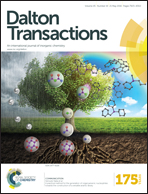Radical non-radical states of the [Ru(PIQ)] core in complexes (PIQ = 9,10-phenanthreneiminoquinone)†
Abstract
9,10-Phenanthreneiminosemiquinonate anion radical (PIQ˙−) complexes of ruthenium of types trans-[RuII(PIQ˙−)(PPh3)2(CO)Cl] (1) and trans-[RuIII(PIQ˙−)(PPh3)2Cl2] (2) are reported. Reactions of 1 and 2 with I2 afford trans-[RuIII(PIQ˙−)(PPh3)2(CO)Cl]+I3−·½CH2Cl2 (1+I3−·½CH2Cl2) and trans-[RuIII2(PIQ˙−)2(PPh3)2(μ-Cl)3]+I3−·¼I2·¼toluene) (3+I3−·¼I2·¼toluene), while the reaction of 2 with Br2 yields a 9,10-phenanthreneiminoquinone (PIQ) complex of the type mer-[RuIII(PIQ)(PPh3)Br3]·½CH2Cl2 (4·½CH2Cl2). In comparison, the reaction of trans-[RuIII(PQ˙−)(PPh3)2Cl2] (2PQ), a 9,10-phenanthrenequinone (PQ) analogue of 2 affords only trans-[RuIII(PQ)(PPh3)2Cl2]+Br3− (5+Br3−). Considering the X-ray bond parameters, EPR spectra and the atomic spin densities obtained from the density functional theory (DFT) calculations, 1 is defined as a PIQ˙− (average C–O/N and C–C lengths, 1.280(2) and 1.453(3) Å) complex of ruthenium(II) while 4 is a neutral PIQ (average C–O, C–N, C–C and C–O/N lengths, 1.248(7), 1.284(7), 1.485(8) and 1.266(7) Å) complex of the ruthenium(III) ion. The single crystal X-ray bond parameters proposed that 1+I3− (average C–O/N and C–C lengths, 1.294(8) and 1.449(9) Å) and 2 (average C–O/N and C–C lengths, 1.289(2) and 1.447(4) Å) are PIQ˙− complexes of ruthenium(III), while the 3+ ion (average C–O/N and C–C lengths, 1.288 ± 0.004 and 1.450 ± 0.017 Å) is a co-facial bi-octahedral complex of ruthenium(III). In contrast, the 5+ ion is a PQ complex of the ruthenium(III) ion. EPR spectra and the calculated atomic spin densities authenticated that the 2+ ion obtained after constant potential coulometric oxidation of 2 is a PIQ complex of ruthenium(III), while the 2− ion is a hybrid state of [RuII(PIQ˙−)] and [RuIII(PIQ2−)] states. It is observed that the PIQ˙− state in which spin is more localized on the nitrogen (∼38% in 1 and ∼35% in 2− ion) is stable and the coordination of the PIQ2− state is not observed in this study. Redox activities, UV-vis/NIR absorption spectra and their origins and the spectroelectrochemical measurements for 2 → 2+, 2 → 2− and 3+ → 32+ conversions are analyzed.
![Graphical abstract: Radical non-radical states of the [Ru(PIQ)] core in complexes (PIQ = 9,10-phenanthreneiminoquinone)](/en/Image/Get?imageInfo.ImageType=GA&imageInfo.ImageIdentifier.ManuscriptID=C6DT00091F&imageInfo.ImageIdentifier.Year=2016)

 Please wait while we load your content...
Please wait while we load your content...